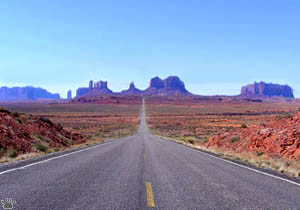
Monument Valley, Arizona/Utah border.
Tame, Tame West
| The American West is probably the most photographed
part of our planet. Not only is it beautiful enough to sustain an army of professional
photographers, it is also very easy to travel around. Excellent roads and relatively
low population density allow you to move fast; all the best places are well-known,
well-marked and easily accessible. Weather is mostly good for taking pictures
(except in the Northwest), wildlife is usually tame, and people are friendly. |
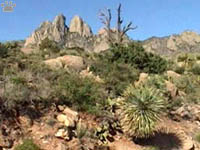
Rabbit Ears Peaks in Organ Mountains,
New Mexico. |

Voluntary park ranger,
Petrified Forest NM, Arizona. |
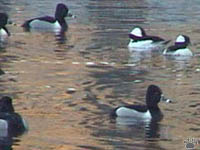
Wintering ducks (Aythya collaris, Bucephala
albeola), White Mountains,
Arizona. |
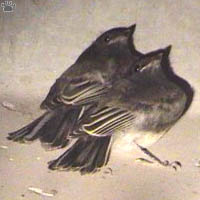
Fledgling black phoebes (Sayornis
nigricans), Gila Wilderness, New Mexico. |
The Wild West of the past is now a legend; the
word "wild" is more relevant to some parts of New York or Chicago. Knowing
all this, I still couldn't abstain from taking pictures here and there, while
driving, flying, hiking, skiing, snowmobiling, rowing, and horseback riding around
the West. |

White-winged doves (Zenaida asiatica),
Dripping Springs NA, New Mexico. |
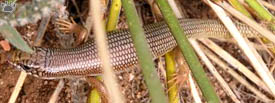
Plains skink (Eumeces obsoletus), Placitas, New Mexico. |
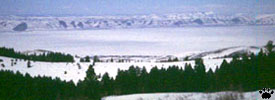
Bear Lake, Utah. |
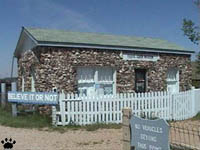 |
There was a time when the West was inhabited by
much larger animals than today. The largest "dinosaur graveyards" in
the World have been discovered in Colorado, Utah, South Dakota and Wyoming. |
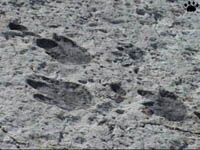 |
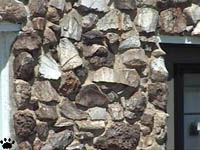
A cabin built of dinosaur bone, Como Bluff. |
Some fossil beds can now be seen in National parks
and other protected areas. But the largest of them all, Como Bluff Dinosaur Graveyard,
is on private land, and can be difficult to get to, at least legally. |
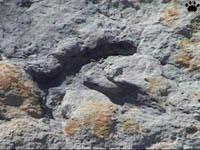
Dinosaur tracks, Morrison, Colorado. |
 |
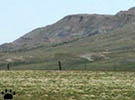 |
 |
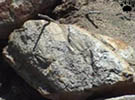 |
| Bone-containing cliffs,
Como Bluff Dinosaur Graveyard, Wyoming. |
Dinosaur bone fragments
in a creek bed, Como Bluff. |
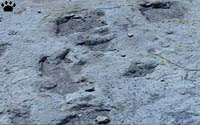
Dinosaur tracks, Lake Clayton, New Mexico. |
Well-preserved dinosaur tracks and
bones are relatively easy to find in many parts of the West, from Southern Canada
to the "Painted Desert" of Arizona and New Mexico. They are not always
obvious: you have to keep your eyes open for unusual shapes and textures. The
problem is, the West is full of unusual shapes and textures, and not all of them
are fossils or ancient tracks. |
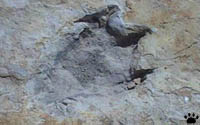
Dinosaur track, Lake Clayton, New Mexico. |
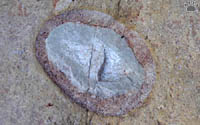
Cross-section of a dinosaur bone in a rock,
Paria River Basin, Utah. |
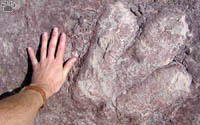
Track of a mid-sized carnivorous dinosaur
(probably Dilophosaurus), Paria River, Utah. |
 |
 |
 |
| Petrified Araucarioxylon tree trunks
and wood pieces, Petrified Forest National Monument, Arizona. |
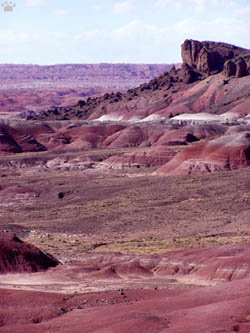
Petrified Forest National Monument, Arizona. |
One fossil site which is hard to miss is Petrified
Forest National Monument in Arizona - the largest and the most impressive of about
twenty "petrified forests" of the West. |
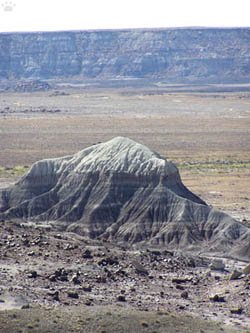
Petrified Forest National Monument, Arizona. |
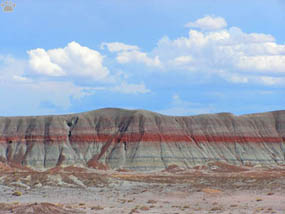 |
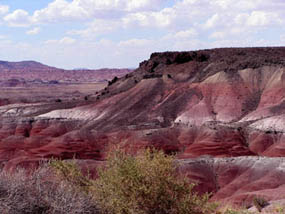 |
| Petrified Forest National Monument,
Arizona. |
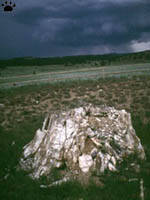 |
There are also thousands of smaller
fossil sites, from Precambrian to recent. Names such as Shell Ridge or Fossil
Creek are common in the West.
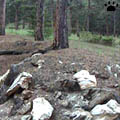 |
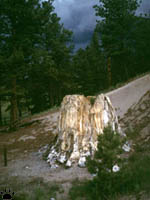 |
| Petrified sequoia stumps,
Florissant Fossil Beds National Monument, Colorado. |

Shell Canyon, Wyoming. |
Among the most interesting places to visit for
a paleontologist are National monuments: Agate Fossil Beds, Nebraska; Fossil Butte,
Wyoming; Florissant Fossil Beds, Colorado; John Day Fossil Beds, Oregon; Hagerman
Fossil Beds, Idaho; Dinosaur, Utah/Colorado border; and National parks: Badlands,
South Dakota and Grasslands, Saskatchewan. |
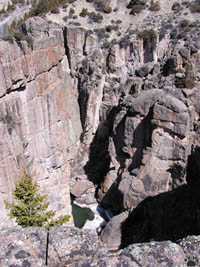
Shell Canyon, Wyoming. |
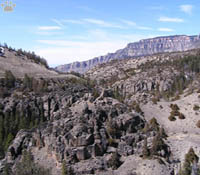
Shell Canyon, Wyoming. |
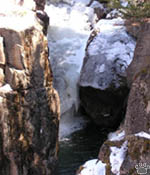
Shell Falls, Wyoming. |

Shell Canyon, Wyoming. |
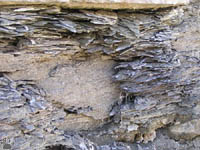
Shale layers containing Cambrian fossils,
Shell Canyon, Wyoming. |
Two sites are famous for fossils documenting the
so-called Cambrian Explosion, when most phyla of multicellar animals have first
appeared: Shell Canyon, Wyoming and, particularly, Burgess Shale, Yoho Nat'l Park,
British Columbia. |
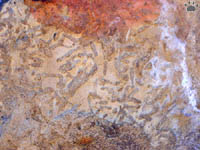
Petrified Devonian wormholes, Shell Canyon,
Wyoming. |
 |
 |
 |
| Petroglyph Nat'l Monument, New Mexico. |

Newspaper Rock, Utah. |
The West has been changed by people at least since
the last ice age. Thousands of ancient ruins and petroglyph-covered rocks are
scattered through its canyons and plains. |
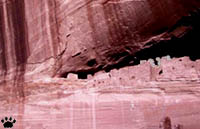
Canyon de Chelly, Arizona. |
 |
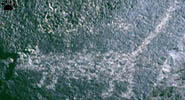
Petroglyph Nat'l Monument, New Mexico. |
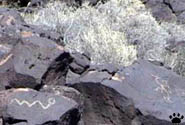 |
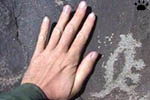
Most rock art at Petroglyph Nat'l
Monument dates back to 1200-1600
AD. New Mexico. |
In New Mexico and adjacent
areas, native cultures had evolved into sophisticated civilizations, of which
the Ancient Puebloan Culture is the most famous because of its stone cities. Many
Anasazi settlements were beautifully placed in canyons and rock overhangs. |

Ancient pueblo (village) of Anasazi,
ancestors of modern Hopi Indians,
Mesa Verde, Colorado. |
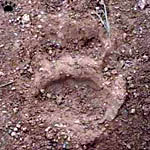
Black bear (Ursus americanus)
track, Colorado. |
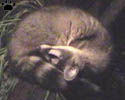 |
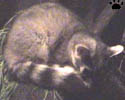 |
| Ringtail (Bassariscus astutus),
Moor Cave, Arizona. |
The West is not just fossils and ruins. It has a lot of present-day wonders. More
about it in the following pages. |
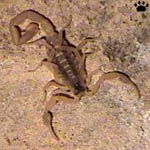
Rock scorpion (Hadrurus
saxatilis), Colorado. |
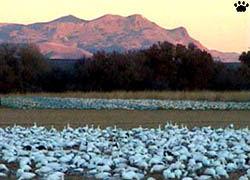
Wintering geese flocks, Bosque del Apache NWR, New Mexico.
Part 2. The Canyon Country
Home
|
|